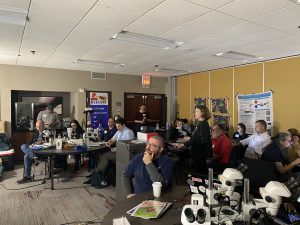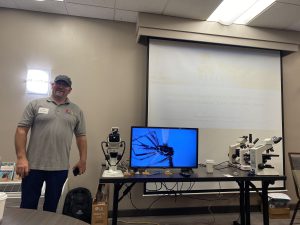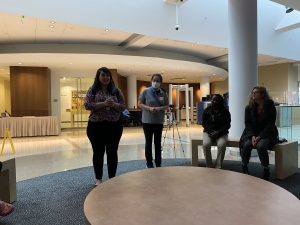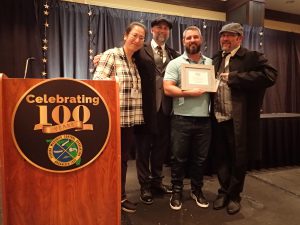BEACONS Annual Workshop Dec 2022
The mosquito BEACONS committee ended 2022 with a BUZZ! We brought together a group of mosquito control and public health experts to hone in on key issues pertaining to invasive mosquito species. The workshop had participants from Puerto Rico, Florida, Georgia, South Carolina, North Carolina, Mississippi, and Texas.
The training was hands on and gave participants a unique opportunity to view curated mosquito specimens. At this year’s workshop we covered the following topics:
- Invasive species distributions
- Morphology
- Bionomics
- Data organization and visualization
- Tips for successful IPM programs
- Tour of the CDC Museum
Click here to view the bionomics and mosquito identification training materials.
Specimens and microscopes were provided by:
- Florida Medical Entomology Laboratory
- Daniel Killingsworth (Environmental Security Pest and Lawn)
- Michael Riles (Central Life Sciences)
- Dr. Brian Byrd (Western Carolina University)
- Dr. Bryan Giordano (Broward County Mosquito Control Section)
Thank you for your support!

Data Organization and Visualization
University of Florida’s Lindsay Campbell (PhD) led an exciting seminar on the open-source GIS platform QGIS. Lindsay showed the group how to download the free program, load data, plot points, and create high-caliber and publication ready maps.
“It’s important to keep good records of your surveillance data, especially if you want to perform downstream analyses or mapping. Give each trap and site a unique identifier and record all pertinent information.” – Dr. Lindsay Campbell

Invasive Mosquito Identification
Michael Riles (Central Life Sciences) summarized key morphology of invasive species in our region and species of interest in surrounding regions. Unique morphology to each invasive species was presented alongside native species, to help taxonomists separate them from the local fauna. Attendees had an opportunity to view specimens under the microscope during the lecture, adding an extra layer to our mosquito identification program.
“Each day is a new day to make a new discovery. Don’t get complacent in your identifications. Think about broadening your horizons; use several dichotomous keys, look for similarities and differences in species, record and keep track of what you find over time. This is how you build an impactful surveillance program” – Michael Riles
Mosquito Bionomics (Dr. Benjamin Allen)
City of Jacksonville’s Benjamin Allen (PhD) shared his knowledge of invasive mosquito bionomics. His passion toward the subject left participants smiling and fully engaged. Ben covered:
- seasonal and geographic distribution
- feeding preferences
- breeding habitat
- sampling bias
- involvement in disease transmission
Mosquito control and public health professionals use bionomics information when deciding sampling method, location, and time and when considering the best mitigation approach.
“Knowledge of mosquito bionomics allows us to anticipate mosquito behavior” – Dr. Benjamin Allen
Integrated Pest Management in Action
Daniel Killingsworth (Environmental Security Pest and Lawn) gave an informative seminar on the keys to successful implementation of integrated pest management (IPM) – communication being at the top of the list.
“Communication is key to the successful implementation of IPM. At any stage in an IPM plan, if communication stops or the message is lost, you will be unsuccessful. Proper communication will help you overcome any limitations you encounter” – Daniel Killingsworth.
Dan reminded the group of trainees that information alone is not communication. Simply stating or listing bullet point facts is not effective communication. A greater effort must be made to engage your audience, whether it be the public, professionals, or researchers.
“The public health mosquito management community should look to the private sector for insights on messaging and promoting value of service” – Daniel Killingsworth
The private sector relies on effective and targeted marketing strategies to reach their desired audience. Programs interested in revamping their social media or website content should look to established content providers for examples of clear and professional presentation of information.

Meeting with Entomologist Dr. Sarah Zohdy
Our workshop included a tour of the David J. Sencer CDC Museum (Atlanta, GA) and a discussion session with CDC scientist Dr. Sarah Zohdy. Dr. Zohdy, is the U.S. President’s Malaria Initiative Entomology Team Lead at CDC. Part of Zohdy’s current work pertains to the invasive Anopheles stephensi, an urban container breeding Anopheles mosquito endemic to South Asia and the Arabian Peninsula. This species has quickly spread throughout Eastern Africa and was recently confirmed in Nigeria (across the continent) and Kenya. The presence of a competent malaria vector in urban spaces could change the landscape of malaria transmission in Africa.
Because of Anopheles stephensi’s affinity for artificial containers, it has been proposed that global trade via shipping containers is a main method of dispersal for this invasive mosquito. It has been found in areas surrounding seaports and in seaport livestock quarantine facilities. An Emory graduate student working with Zohdy compiled data on maritime trade between An. stephensi endemic countries and seaports in Africa to determine inter- and intra-continental connectivity. They found that the initial invasive An. stephensi detections in Africa were in the countries that were the most highly connected (via maritime trade) to regions where this mosquito is endemic. This global trade information when combined with habitat suitability data for An. stephensi can be used to predict An. stephensi invasion into new locations to halt further spread of the species. Dr. Zohdy‘s research suggests that targeted larval surveillance around high-risk ports could aid in early identification of An. stephensi introductions.
Read more about Dr. Zohdy‘s exciting research by clicking here.
Dr. Zohdy‘S final remarks were aimed at undergraduate and graduate students.
“Never stop being curious. Ask questions and seek answers” – Dr. Sarah Zohdy
Funding and Support
We are supported by the Southern IPM Center (Project S21-002) as part of the USDA National Institute of Food and Agriculture Crop Protection and Pest Management Regional Coordination Program (Agreement No. 2018-70006-28884).
BEACONS is proud to support undergraduate and graduate student education and networking opportunities. Dr. Campbell was accompanied by her two graduate students, Amy and Yasmin, who provided technical expertise and helped guide participants through the modules. And we thank Xiaodi and Valerie (Dr. Yoosook Lee’s graduate students) for their help organizing CEU credits and for providing logistical support during the workshop.
 0
0

